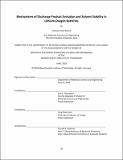| dc.contributor.advisor | Carl V. Thompson and Yang Shao-Horn. | en_US |
| dc.contributor.author | Batcho, Thomas Peter | en_US |
| dc.contributor.other | Massachusetts Institute of Technology. Department of Materials Science and Engineering. | en_US |
| dc.date.accessioned | 2018-09-17T14:49:26Z | |
| dc.date.available | 2018-09-17T14:49:26Z | |
| dc.date.copyright | 2018 | en_US |
| dc.date.issued | 2018 | en_US |
| dc.identifier.uri | http://hdl.handle.net/1721.1/117783 | |
| dc.description | Thesis: Ph. D., Massachusetts Institute of Technology, Department of Materials Science and Engineering, 2018. | en_US |
| dc.description | This electronic version was submitted by the student author. The certified thesis is available in the Institute Archives and Special Collections. | en_US |
| dc.description | Cataloged student-submitted from student-submitted PDF version of thesis. | en_US |
| dc.description | Includes bibliographical references. | en_US |
| dc.description.abstract | Lithium-oxygen batteries offer the possibility of achieving twice the gravimetric energy density of lithium-ion batteries. However, several challenges remain to achieve commercially-available lithium-oxygen batteries. Capacity must be optimized by maximizing the formation of Li₂O₂ discharge product. Side reactions with the solvent and electrode must be suppressed. This study seeks to improve understanding of the mechanisms of Li₂O₂ evolution and Li-O₂ decomposition reactions in order to design strategies to optimize capacity and stability. Decomposition reactions in the solvent dimethyl sulfoxide were studied due to conflicting reports about its stability. Discharged electrodes in dimethyl sulfoxide were aged for varying amounts of time then characterized. Li₂O₂ reacted with dimethyl sulfoxide to form LiOH and dimethyl sulfone. This demonstrated that dimethyl sulfoxide is unsuitable for commercial application. The study also illustrated the importance of performing aging studies in the discharged condition to determine the stability of Li-O₂ battery components. Adding small amounts of water to Li-O₂ solvents has been demonstrated to enhance capacity but the effect on stability was not well understood. Discharges were performed in dimethoxyethane and acetonitrile with and without added water. Water caused an unwanted side reaction to form LiOH in acetonitrile but not in dimethoxyethane, due to a higher favorability of deprotonation in acetonitrile. Interactions between capacity enhancing additives and solvent molecules must be carefully studied to avoid side reactions. A model of the two competing mechanistic pathways of Li-O₂ discharge was developed to understand how these pathways depend on discharge conditions and solvent properties. The model was fitted to experimental results from rotating ring-disk electrode discharges in order to check that model assumptions were physical. The model demonstrates that Li₂O₂ film evolution is heavily dependent on solvent properties and that promotion of toroidal Li₂O₂ primarily depends on slower surface passivation rather than faster solvation of lithium superoxide. | en_US |
| dc.description.statementofresponsibility | by Thomas Peter Batcho. | en_US |
| dc.format.extent | 131 pages | en_US |
| dc.language.iso | eng | en_US |
| dc.publisher | Massachusetts Institute of Technology | en_US |
| dc.rights | MIT theses are protected by copyright. They may be viewed, downloaded, or printed from this source but further reproduction or distribution in any format is prohibited without written permission. | en_US |
| dc.rights.uri | http://dspace.mit.edu/handle/1721.1/7582 | en_US |
| dc.subject | Materials Science and Engineering. | en_US |
| dc.title | Mechanisms of discharge product evolution and solvent stability in lithium-oxygen batteries | en_US |
| dc.type | Thesis | en_US |
| dc.description.degree | Ph. D. | en_US |
| dc.contributor.department | Massachusetts Institute of Technology. Department of Materials Science and Engineering | |
| dc.identifier.oclc | 1051190541 | en_US |
